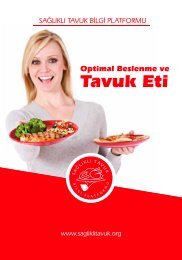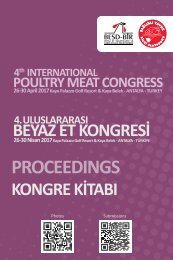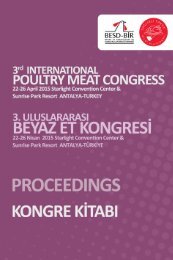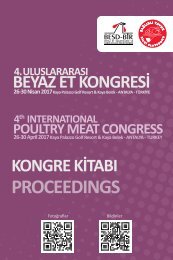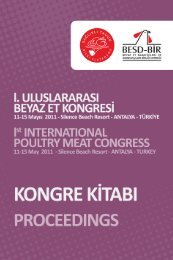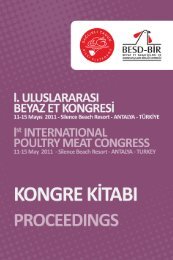- Page 4 and 5:
Sağlıklı Tavuk Bilgi Platformu (
- Page 6 and 7:
Önsöz Organizasyon ve Komiteler P
- Page 8 and 9:
Avrupa ve Ortadoğu’nun beyaz et
- Page 10 and 11:
NO S01 S02 S03 S04 S05 S06 S07 SÖZ
- Page 12 and 13:
S39 S40 S41 S42 S43 S44 S45 S46 S47
- Page 14 and 15:
P16 P17 P18 P19 P20 P21 P22 P23 P24
- Page 16 and 17:
SÖZLÜ BİLDİRİLER
- Page 18 and 19:
damızlık yetiştiriciliği organi
- Page 20 and 21:
yetiştiricileri yemi gıdaya yüks
- Page 22 and 23:
Ancak büyütme döneminde sözkonu
- Page 24 and 25:
Tablo 7. Çıkımdan 60 haftalık o
- Page 26 and 27:
2014, 93(9):2151-2157. 12. Hocking
- Page 28 and 29:
ve 11 Eylül saldırılarından son
- Page 30 and 31:
Özet • Politika yapanlar kamuoyu
- Page 32 and 33:
Sonuç Kamuoyu - gerçek or kurmaca
- Page 34 and 35:
Geçtiğimiz 1 Sene İçerisinde Ta
- Page 36 and 37:
Söylentilerin Tavuk Tüketim Alı
- Page 38 and 39:
Beslenme konusunda hastalarına ön
- Page 40 and 41:
Sonuçlar 1.000 hekim ile yapılan
- Page 42 and 43:
Embriyo sıcaklığı 50 yıldan da
- Page 44 and 45:
yüksek bir EST (>40.0°C) özellik
- Page 46 and 47:
ısısı gerekse metabolizma hızı
- Page 48 and 49:
ve ark. (2007) kuluçkanın 4 ila 7
- Page 50 and 51:
embryo physiology. Poult. Sci. 93:6
- Page 52 and 53:
S 04 Kuluçkalık Yumurtalarda Kull
- Page 54 and 55:
Bulgular ve Tartışma Araştırmad
- Page 56 and 57:
Scotland 4. Pas Reform 2012. Pas Re
- Page 58 and 59:
haftalarda yemden yararlanma oranla
- Page 60 and 61:
genotipler için tespit edilen değ
- Page 62 and 63:
Hayvancılık Ulusal Kongresi (1),
- Page 64 and 65:
Tablo 6. I. Dönem (0-8 hafta) Grup
- Page 66 and 67:
Kaynaklar : 1. Directive 2001/18/EC
- Page 68 and 69:
ve teknoloji arasındaki ilişkiyi
- Page 70 and 71:
Tablo2: Soya küspesi ve mısırın
- Page 72 and 73:
S 08 Türkiye’de Rendering Ürün
- Page 74 and 75:
Çeşitli gıdalarla vücuda giren
- Page 76 and 77:
taşınması, depolanması, işlenm
- Page 78 and 79:
Kullanımdaki Yasaklar Tablo 5. Ren
- Page 80 and 81:
İmha metotları KATEGORİ 1 Yakma
- Page 82 and 83:
yemleri, balık yemler ve kanatlı
- Page 84 and 85:
Tablo 9. Toplam rendering ürün mi
- Page 86 and 87:
animal by-products not intended for
- Page 88 and 89:
Risk Analizi Gelecekteki gıda güv
- Page 90 and 91:
Sonuç Yukarıda bahsedilen hususla
- Page 92 and 93:
ağlıdır [2,3]. Gıdalarda ppb d
- Page 94 and 95:
ileşikler 4,8-DiMeIQx, PhIP ve MeI
- Page 96 and 97:
HAA’lar, et ve et ürünlerinin p
- Page 98 and 99:
Çizelge 3: Tavuk dönerlerin kreat
- Page 100 and 101:
aromatik aminlerin oluşumu üzerin
- Page 102 and 103:
Beyaz çizgiler: Beyaz çizgiler (W
- Page 104 and 105:
muscle and breast meat quality of b
- Page 106 and 107:
Havalandırma Nasıl Çalışır En
- Page 108 and 109:
tarz fan kurulumu dışarıdaki hav
- Page 110 and 111:
Minimum Havalandırma Nasıl Çalı
- Page 112 and 113:
aşına kullanıldığında, hava s
- Page 114 and 115:
soğuk ve sıcak havada maksimum ra
- Page 116 and 117:
S 13 Etlik Piliçlerde Kümes İçi
- Page 118 and 119:
düşük bulunmuştur. Bu bulgu, ı
- Page 120 and 121:
Grafik 1. 2010-2011 yılları aras
- Page 122 and 123:
S 14 Sürü Yaşı, Çıkış Zaman
- Page 124 and 125:
Bulgular ve Tartışma Sürü yaş
- Page 126 and 127:
Grafik 4’den de görüleceği üz
- Page 128 and 129:
S 15 Veteriner Sağlık Ürünleri
- Page 130 and 131:
114
- Page 132 and 133:
diğer muhtemel sorunların saptanm
- Page 134 and 135:
118
- Page 136 and 137:
S 16 Broyler Üretiminde Salmonella
- Page 138 and 139:
Tablo 1. Entegrelere ait suş sayı
- Page 140 and 141:
Microbiol. 1995; 33: 2637-2642. 6.
- Page 142 and 143:
Kalite Kontrol GMP’nin bir parça
- Page 144 and 145:
Yumurtacı sürülerde (Gallus gall
- Page 146 and 147:
İlk kontrol metodu olarak aşılam
- Page 148 and 149:
Salmonella’ya karşı zorunlu aş
- Page 150 and 151:
S 18 Beslenme ve Kanser: Doğrular,
- Page 152 and 153:
136
- Page 154 and 155:
V) ÜRETİM/SAKLAMA/İŞLEME/PİŞ
- Page 156 and 157:
YAĞ = Gereksiz ve zararlı bir yü
- Page 158 and 159:
ÇELİŞKİLİ Yeşil çay tepeden
- Page 160 and 161:
HANGİSİNİ DUYMADINIZ? Taşta otu
- Page 162 and 163:
Uzmanlık Alanı: Radyasyon Onkoloj
- Page 164 and 165:
Uzmanlık Alanı: Kardiyoloji Dunni
- Page 166 and 167:
S 19 GDO ile İlgili Gelişmeler: T
- Page 168 and 169:
Şekil 1. GDO üretiminin ekonomik
- Page 170 and 171:
transgenesis yani gen aktarma yoluy
- Page 172 and 173:
siyasetçilerin ve çıkar gruplar
- Page 174 and 175:
Türkiye ekonomisi üzerine getirdi
- Page 176 and 177:
Kanatlı Altlığından Enerjiye Bi
- Page 178 and 179:
162
- Page 180 and 181:
- Daha büyük güç üretim kapasi
- Page 182 and 183:
temizlemektedir. Ancak girdi yakıt
- Page 184 and 185:
Biokütle yakma Biyokütle yakma -
- Page 186 and 187:
170
- Page 188 and 189:
1) Elektrik üretimine bağlı 2) G
- Page 190 and 191:
• Teşvik primi talep edebilmek i
- Page 192 and 193:
S 21 Tavuk Atıklarının Gübre Ol
- Page 194 and 195:
Tavukta üreme organları, kalın b
- Page 196 and 197:
larak çok daha kaliteli bir organi
- Page 198 and 199:
S 22 Taze ve Kompost Edilmiş Etlik
- Page 200 and 201:
Çizelge 2.1 Araştırmada kullanı
- Page 202 and 203:
aldığı, %1 ve %2 gübre dozları
- Page 204 and 205:
S 23 Hindi Etinde Listeria Monocyto
- Page 206 and 207:
Tablo 1. Rapor edilen hindi eti ve
- Page 208 and 209:
Listeria monocytogenes’in Biyokon
- Page 210 and 211:
profiles of Listeria monocytogenes
- Page 212 and 213:
S 24 Çoklu Antibiyotik Dirençli S
- Page 214 and 215:
kinolonların da dahil olduğu bir
- Page 216 and 217:
(RTE) ile tüketime hazır olmayan
- Page 218 and 219:
S 26 Kanatlı Besleme Nereye Gidiyo
- Page 220 and 221:
asit miktarları temel alınmışt
- Page 222 and 223:
Mısır, sorgum ve pirinç gibi non
- Page 224 and 225:
23. Choct M, Annison G. Anti-nutrit
- Page 226 and 227:
Koksidiyozun hayvanın sağlığı
- Page 228 and 229:
Bitkisel preparatlar Tıbbi-aromati
- Page 230 and 231:
Bağırsak epitel yüzeyinde patoje
- Page 232 and 233:
--Alternatif uygulamaların yayılm
- Page 234 and 235:
Elmusharaf, M.A., Peek, H.W., Nolle
- Page 236 and 237:
S 28 Farklı Düzeyde Kalsiyum ve F
- Page 238 and 239:
S 29 Etlik Piliç Yemlerinde Metiyo
- Page 240 and 241:
Şekil 1. Metiyonin metabolizması
- Page 242 and 243:
sodyum gereksinimlerini karşılama
- Page 244 and 245:
sınırlayıcı aminoasit durumunda
- Page 246 and 247:
21. Esteve-Garcia, E. and Austic, R
- Page 248 and 249:
S 30 Kuluçkanın Gelişim Dönemin
- Page 250 and 251:
Çizelge 1. Denemelerdeki nem seviy
- Page 252 and 253:
S 31 Broiler Damızlıklarda Üreti
- Page 254 and 255:
Deneme 2 12.9 × 140 m boyutundaki
- Page 256 and 257:
Deneme 3 14 × 120 m boyutundaki 4
- Page 258 and 259:
Sonuç Dişi yemlik uzunluğunun ta
- Page 260 and 261:
Üretim döneminde tavsiye edilen d
- Page 262 and 263:
246
- Page 264 and 265:
Hedefimiz Ne Olmalı? Katalog değe
- Page 266 and 267:
ve vitaminleri bulunmalıdır. Baş
- Page 268 and 269:
Yumurtlama Öncesi Evre Yumurtlama-
- Page 270 and 271:
günlük proteine ihtiyaç duydukla
- Page 272 and 273:
in Broiler Breeders. Poult. Sci. 79
- Page 274 and 275:
S 33 Hindi Kuşbaşı Örneklerinde
- Page 276 and 277:
Seçilen van A ve van B genlerinin
- Page 278 and 279:
Autgaerden TV, Chapelle S, Lammens
- Page 280 and 281:
S 34 Broylerler Beslemede Kullanıl
- Page 282 and 283:
anlamında düşünülmelidir. Bu k
- Page 284 and 285:
azaltır ve aynı zamanda yaşama p
- Page 286 and 287:
S 35 Ketencik Küspesinin 4-haftal
- Page 288 and 289:
Örneklerde ham enerji düzeyi adia
- Page 290 and 291:
CM2 için ME değerleri 882 ve 925
- Page 292 and 293:
Tablo 2.Başlangıç ve Deneme Yeml
- Page 294 and 295:
Şekil 1. İki ketencik küspesine
- Page 296 and 297:
Genetik faktörler Kanserlerin heps
- Page 298 and 299:
Besinlerde kullanılan sodyum veya
- Page 300 and 301:
Et kanser riskini arttırıyor mu?
- Page 302 and 303:
Beyaz et Meme kanserinden koruyor m
- Page 304 and 305:
288
- Page 306 and 307:
Katkı Maddeleri ve Kanser Ticari g
- Page 308 and 309:
S 37 Bebeklikten Ergenliğe Sağlı
- Page 310 and 311:
294
- Page 312 and 313:
296
- Page 314 and 315:
298
- Page 316 and 317:
300
- Page 318 and 319:
Gebe Beslenmesi Sorunlar ve Önceli
- Page 320 and 321:
Beslenme Sorunları Yetişkin kadı
- Page 322 and 323:
306
- Page 324 and 325:
308
- Page 326 and 327:
310
- Page 328 and 329:
312
- Page 330 and 331:
314
- Page 332 and 333:
316
- Page 334 and 335:
318
- Page 336 and 337:
Tablo 1. Farklı hatlardan gelen 6
- Page 338 and 339:
dönemde et kalitesi için yapılan
- Page 340 and 341:
Sonuç Broyler özellikleri için g
- Page 342 and 343:
S 39 Gıda Güvenilirliği ve Pili
- Page 344 and 345:
328
- Page 346 and 347:
Gıda Alışverişlerinde Tercihler
- Page 348 and 349:
332
- Page 350 and 351:
Gıda Güvenliği Sorunları Gerçe
- Page 352 and 353:
Analysis of the baseline survey on
- Page 354 and 355:
Global Çözüm Yeni Gıda Güvenli
- Page 356 and 357:
çiftleştirilmesi ile elde edilir.
- Page 358 and 359:
Piliç etinin lezzetli bulunması y
- Page 360 and 361:
nın %95’i GDO) ülkemizde yeters
- Page 362 and 363:
Phipps, R.H. and Beever, D.E., 2000
- Page 364 and 365:
yararlanma ile ulaşabilen ve yaşa
- Page 366 and 367:
Piliç kesimindeki aşamalarda uygu
- Page 368 and 369:
tanımlanan elektrikle şoklamada t
- Page 370 and 371:
olarak görülmemektedir. Türkiye
- Page 372 and 373:
S 42 Kanatlı Etinin İşlenmesinde
- Page 374 and 375:
tüylerin arasına iyice nüfuz etm
- Page 376 and 377:
Tüy yumuşatmada olduğu gibi pek
- Page 378 and 379:
S 43 Tavuk Etinden Pastırma Aromal
- Page 380 and 381:
→ → a) Parçalama b) Homojeniza
- Page 382 and 383:
S 44 Kesimhanelerden Alınan Piliç
- Page 384 and 385:
1 Minishaker, Wilmington, NC, ABD).
- Page 386 and 387:
Sonuç Bu çalışmada üç farklı
- Page 388 and 389:
süresini uzatmak ve lezzet gelişi
- Page 390 and 391:
Tartışma ve Sonuç Deneysel köft
- Page 392 and 393:
chilled storage. Food Hydrocolloids
- Page 394 and 395:
Tablo 1 Proses 1 ve Proses 2 tetikl
- Page 396 and 397:
A. Yaygın durumlar B. Ortak “ted
- Page 398 and 399:
Materyal ve Metot Bu çalışma Ulu
- Page 400 and 401:
kötüleşmesi ve yüksek düzeydek
- Page 402 and 403:
S 48 Maternal Stresin Olumsuz Küme
- Page 404 and 405:
Verilerin analizinde SAS statistica
- Page 406 and 407:
Lay DC, Wilson ME. Development of t
- Page 408 and 409:
Çizelge 3. Hareketsiz kalma süres
- Page 410 and 411:
Tablo 1: Dünya Kanatlı Eti Üreti
- Page 412 and 413:
Tablodan da görüldüğü üzere T
- Page 414 and 415:
işleyerek pazara sunmaktadır. Sö
- Page 416 and 417:
Sonuç ve Öneriler Broiler (etlik
- Page 418 and 419:
Belirgin IBV alt popülasyonların
- Page 420 and 421:
S 51 Kanatlılarda Mikrobiyom ve Ha
- Page 422 and 423:
Son yıllarda geliştirilen yeni ne
- Page 424 and 425:
neden olabileceği noktasına dikka
- Page 426 and 427:
Şekil 3. Doku örneklerinin TaqMan
- Page 428 and 429:
Tartışma Türkiye, dünyada büy
- Page 430 and 431:
S 53 Broyler Piliçlerde Sıcaklık
- Page 432 and 433:
etkilerinin çok daha fazla zararl
- Page 434 and 435:
Quanteiro-Filho, W.M., A.V.S. Gomes
- Page 436 and 437:
POSTER TEBLİĞLER 420
- Page 438 and 439:
Materyal ve Metot Çalışmada 272
- Page 440 and 441:
ahatsızlığını azaltarak ve ref
- Page 442 and 443:
Tablo 1. Bazı stres parametreleri
- Page 444 and 445:
P 02 Japon Bıldırcınlarında Erk
- Page 446 and 447:
Ad libitum, %15 ve %30 yem sınırl
- Page 448 and 449:
Tablo 1. Yem sınırlama ve cinsiye
- Page 450 and 451:
P 03 Damızlık Broyler Rasyonları
- Page 452 and 453:
kullanılarak ölçülmüştür. He
- Page 454 and 455:
sonucuna varılmıştır. Kuluçka
- Page 456 and 457:
Tablo 2. Bitkisel (Solanum glaucoph
- Page 458 and 459:
Control Point (HACCP)] ve farklı d
- Page 460 and 461:
verilmiştir. Salmonella spp. sayı
- Page 462 and 463:
6. Sofos JN, Smith GC. Nonacid meat
- Page 464 and 465:
Bu derleme kanatlı eti sektörü v
- Page 466 and 467:
depolanması sırasında toplam can
- Page 468 and 469:
and Salmonella serotype Typhimurium
- Page 470 and 471:
P 06 Listeria monocytogenes ile Kon
- Page 472 and 473:
olduğunu bildirmişlerdir. Bu ara
- Page 474 and 475:
Grafik 1. Listeria monocytogenes il
- Page 476 and 477:
avantaj sağlayabilir (2). Bunlara
- Page 478 and 479:
Bunlar; mikrabiyal, kimyasal, toksi
- Page 480 and 481:
Shono K (Ed.), Forest insects as fo
- Page 482 and 483:
olarak tanımlanmaktadır (5). Bir
- Page 484 and 485:
Tablo 2. Gruplardan elde edilen bes
- Page 486 and 487:
aksine, etlik piliç rasyonlarına
- Page 488 and 489:
87. In: Muzarelli, R.A.A. and Paris
- Page 490 and 491:
P 09 Tavuk Sindirim Sistemi İn Vit
- Page 492 and 493:
örneklerin absorbansı 430 nm’de
- Page 494 and 495:
Kaynaklar [1] Tarım Gıda ve Hayva
- Page 496 and 497:
havuç lifi ve karragenan gamı etk
- Page 498 and 499:
P 11 Etlik Piliç Karma Yemlerine
- Page 500 and 501:
ağırlıkları eşit olacak şekil
- Page 502 and 503:
spp. sayısını arttırmış ve E.
- Page 504 and 505:
Bilimleri Enstitüsü, Yüksek Lisa
- Page 506 and 507:
Çizelge 2. Etlik piliç yemlerine
- Page 508 and 509:
Araştırma verileri JMP istatistik
- Page 510 and 511:
Grafik 4-Öğrencilerin tavuklarda
- Page 512 and 513:
Kaynaklar Arslan P, Mercanlıgil S,
- Page 514 and 515:
döneminde performans ve ölüm ora
- Page 516 and 517:
Çizelge 1. Damızlık yaşı, üre
- Page 518 and 519:
ortalama ölüm oranlarının İngi
- Page 520 and 521:
P 14 AB ve Türkiye’de Kanatlı B
- Page 522 and 523:
görürler. Dolayısıyla bu konak
- Page 524 and 525:
esinsel, tıbbi ve ekonomik gerekç
- Page 526 and 527:
Mohammed, H. H, Badawi, M. E, Walaa
- Page 528 and 529:
membranından sentezlenen, 16kDa b
- Page 530 and 531:
Kaynaklar 1. Aslan, A.: Et muayenes
- Page 532 and 533:
planlanması, haşere kontrolü, ku
- Page 534 and 535:
12. Bull S.A., Thomas A., Humphrey
- Page 536 and 537:
şart koşulmuştur (Council Direct
- Page 538 and 539:
P 18 Avrupa Birliği’ne Kanatlı
- Page 540 and 541:
ürünlerin bu ülkelere de ihracat
- Page 542 and 543:
P 19 Etlik Piliç Rasyonlarına Far
- Page 544 and 545:
Bulgular Araştırmanın ilk dönem
- Page 546 and 547:
Corzo, A., Loar, Ii, R.E., Kidd, M.
- Page 548 and 549:
Çizelge- 3 Grupların Ortalama Kar
- Page 550 and 551:
türlerinin sayılarında 1990’da
- Page 552 and 553:
Bununla birlikte bölgenin günlük
- Page 554 and 555:
P 21 Ülkemizde Piliç Eti Renginde
- Page 556 and 557:
Tablo 1. Et kalite özelliklerine a
- Page 558 and 559:
Tablo 2. Et kalite özellikleri üz
- Page 560 and 561:
11-20. 4. Radu, C.V., Popescu-Miclo
- Page 562 and 563:
P 22 Etlik Piliçlerde Abdominal Ya
- Page 564 and 565:
ir çok araştırıcının ilgi oda
- Page 566 and 567:
22. Tumova, E., and Teimouri, A., F
- Page 568 and 569:
Literatürde kitosan ve oregano ya
- Page 570 and 571:
Tartışma Mikrobiyolojik Değerlen
- Page 572 and 573:
15. Kurtcan Ü, Gönül M. Gıdalar
- Page 574 and 575:
P 24 Etlik Tavuk Gübrelerinin Komp
- Page 576 and 577:
Kompostlama İşlemi Kompostlama i
- Page 578 and 579:
içeriğinin üç ay sonunda 36,2
- Page 580 and 581:
P 25 Etlik Hindilerde Kümeste ve K
- Page 582 and 583:
dermatiti problemi gözlendiğini b
- Page 584 and 585:
Grafik 2. Kesimhanede yapılan ayak
- Page 586 and 587:
aksine, P toprakta nispeten hareket
- Page 588 and 589:
Ekspanderler sayesinde N sindirileb
- Page 590 and 591:
spectrometry. J Agric Eng Res 1995;
- Page 592 and 593:
P 27 Tavuk Kesimhane Yan Ürünleri
- Page 594 and 595:
Kanatlı yan ürünlerinden protein
- Page 596 and 597:
P 28 Bir Bitki Ekstrakt İçeriği
- Page 598 and 599:
Bu sonuç, artan oranlarda enginar
- Page 600 and 601:
Nir, I., Twina, Y., Grossman, E., N
- Page 602 and 603:
Tablo 2: Diyet Formu ile Diyete İl
- Page 604 and 605:
P 29 Broiler Piliçlerde Optimum Ke
- Page 606 and 607:
yüksek olduğu ifade edilmektedir.
- Page 608 and 609:
P 30 Kanatlı Et ve Et Ürünlerind
- Page 610 and 611:
sırasında denatüre olması ve bu
- Page 612 and 613:
primerlerin dikkatli seçilmesi, ba
- Page 614 and 615:
method for species identification.
- Page 616 and 617:
inaktivasyonuna, enzimlerin inaktiv
- Page 618 and 619:
sıvının proses öncesi ve sonras
- Page 620 and 621:
604
- Page 622 and 623: 606 Şekil 6. YHB ile proses edilen
- Page 624 and 625: asitin birlikte ilavesi yemden yara
- Page 626 and 627: Çalışmamızda yem tüketimi rasy
- Page 628 and 629: 4. Kubena, L.F., Harvey, R.B., Huff
- Page 630 and 631: Tablo 2. Araştırmada kullanılan
- Page 632 and 633: Tablo 5. Deneme gruplarında kan se
- Page 634 and 635: ölümlerin artması ile karakteriz
- Page 636 and 637: Selenyumun Kuluçka Verim Özellikl
- Page 638 and 639: Sonuç GSH-Px enziminin yapısında
- Page 640 and 641: yapılan anketlerden elde edilen ve
- Page 642 and 643: kavramını hiç duymayanların say
- Page 644 and 645: P 35 Tavuk Eti Kalitesi Üzerine Do
- Page 646 and 647: ve göğüs ile but etinde TBARM an
- Page 648 and 649: ile birlikte göğüs ve but etinde
- Page 650 and 651: Kaynaklar 1. Kolsarıcı N, Turhan
- Page 652 and 653: P 36 Broyler Damızlıklarda Amino
- Page 654 and 655: Şekil 1. 43-55 haftalık yaştaki
- Page 656 and 657: kolaylaşmakta ve vücut ağırlı
- Page 658 and 659: Kimi zaman ticari yemler halen mini
- Page 660 and 661: 21. Basiouni GF. The effect of feed
- Page 662 and 663: uzar ve ileumda mikroorganizmalar i
- Page 664 and 665: özellikle Bacillus ve Clostridia t
- Page 666 and 667: 9. Ward, N.E. and Fodge, D.W.: Ingr
- Page 668 and 669: P 38 Kanatlı Besleme Çevre İliş
- Page 670 and 671: kapatılması için karma yemlere i
- Page 674 and 675: minerals versus inorganic forms cre
- Page 676 and 677: Bu anlamda yapılan çalışmalarda
- Page 678 and 679: Kekik esansiyel yağı verilen grup
- Page 680 and 681: Tablo 1. Denemede kullanılan yemin
- Page 682 and 683: P 40 İstanbul İlinde Satışa Sun
- Page 684 and 685: tüy yolma, iç organ çıkartma, s
- Page 686 and 687: fluoresan boyalarla işaretlenmesi
- Page 688 and 689: P 41 Türkiye’deki Kanatlı Sekt
- Page 690 and 691: yüksek olduğu illerin belirlemesi
- Page 692 and 693: Çizelge 1 Kanatlı Eti Üretim Faa
- Page 694 and 695: P 42 Kanatlı Hayvan Üretiminde Ye
- Page 696 and 697: Transkriptomik/ mikroarray Affymetr
- Page 698 and 699: 85:812-822. 15. Kim D. K., Lillehoj
- Page 700 and 701: sayısını (YDS) değiştirmediği
- Page 702 and 703: Diğer etkileri Fitazla ilgili; ba
- Page 704 and 705: Kaynaklar 1. Cosgrove, D.J., 1980.
- Page 706 and 707: P 44 Yeme Antikoksidiyal Monensin v
- Page 708 and 709: praecox and E. mitis) sporlanmış
- Page 710 and 711: Referanslar Basmacıoğlu, M. H.,
- Page 712: Tablo 2. Kekik esansiyel yağı ve
- Page 733:
Notlar / Notes:




